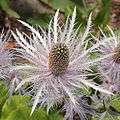Eryngium alpinum
| Eryngium alpinum | |
|---|---|
| | |
| Scientific classification | |
| Kingdom: | Plantae |
| (unranked): | Angiosperms |
| (unranked): | Eudicots |
| (unranked): | Asterids |
| Order: | Apiales |
| Family: | Apiaceae |
| Genus: | Eryngium |
| Species: | E. alpinum |
| Binomial name | |
| Eryngium alpinum L. | |
| Wikispecies has information related to: Eryngium alpinum |
| Wikimedia Commons has media related to Eryngium alpinum. |
Eryngium alpinum (alpine sea holly, alpine eryngo or queen of the Alps) is a perennial herb in the family Apiaceae.
Description
Eryngium alpinum is a hemicryptophyte, its overwintering buds are situated just below the soil surface and the floral axis more or less erect with a few leaves.[1] The roots are deep and robust.
The stems are solitary and erect, usually with three branches on the apex and with longitudinal purple stripes. This plant generally reaches about 30–70 centimetres (12–28 in) in height,[1] with a maximum of 100 centimetres (39 in). The basal leaves are oval or heart-shaped, 10–15 centimetres (3.9–5.9 in) wide and 13–17 centimetres (5.1–6.7 in) long,[1] with toothed hedges and a long petiole. The cauline leaves are sessile and progressively more divided.[1]
The inflorescences are dense umbels at the top of the main branches. They are bright green at the bases and the stiff, bristly bracts are blue. They are about 4 cm long and 2 cm diameter and the bracts are up to 25 centimetres (9.8 in) long.[1] The flowers inside are about 2 mm long. The peripheral flowers are sterile and the internal flowers are hermaphroditic. Both types are actinomorphic and pentamerous, with five petals. Flowering occurs in July through September.[1] The flowers are -insect-pollinated. The fruit is a spiny achene about half a centimeter wide.[1]
Distribution & Habitat
This plant is native to Austria, Liechtenstein, Croatia, France, Switzerland, Italy, and Slovenia.[2][3] It grows in subalpine scrub, rocky areas and wet pastures, preferably in limestone, at an altitude of 1,500–2,000 metres (4,900–6,600 ft) above sea level.[1]
Cultivation

E. alpinum is cultivated as an ornamental plant for its blue and purple flowerheads. It requires dry, well-drained soil and full sun.[4]
Conservation
Wild populations of the species are in decline due to overcollection for ornamental use and habitat degradation from recreational activity and grazing. Numerous local extinctions of subpopulations have occurred.[2]
Gallery
 Eryngium alpinum from Atlas der Alenflora, 1882
Eryngium alpinum from Atlas der Alenflora, 1882- Form

- Inflorescences
References
- 1 2 3 4 5 6 7 8 Pignatti S. - Flora d'Italia – Edagricole – 1982. Vol. II, pag. 176
- 1 2 Gygax, A., et al. 2011. Eryngium alpinum. In: IUCN 2013. IUCN Red List of Threatened Species. Version 2013.1. Downloaded on 08 July 2013.
- ↑ Schede di Botanica
- ↑ Eryngium alpinum. Royal Horticultural Society.
External links
- Flora Europaea: Eryngium alpinum
- Germplasm Resources Information Network—GRIN: Eryngium alpinum
- Biolib: Eryngium alpinum
- Acta Plantarum: Eryngium alpinum
